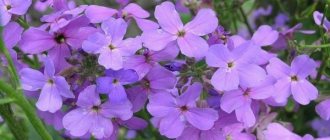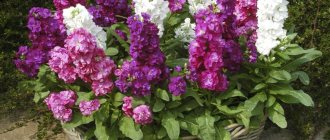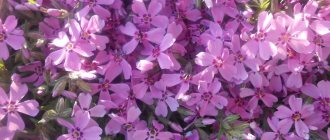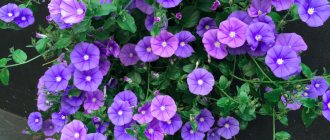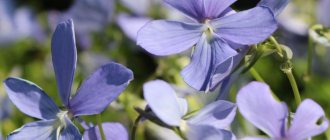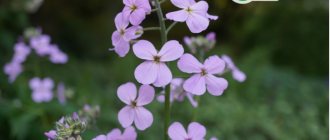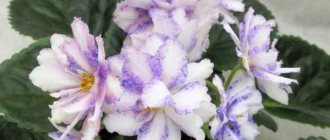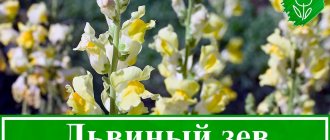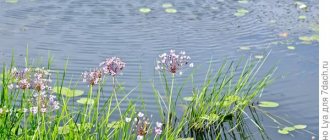The perennial or biennial herbaceous plant Hesperis, also called night violet, or hesperis, is a member of the Cruciferous (Cabbage) family. This genus unites more than 50 species; in nature they can be found in Central Asia, Central Europe and the eastern Mediterranean. The scientific name of such a plant comes from the Greek word translated as “evening.” The fact is that after sunset the smell of the flowers of the evening plant becomes stronger. The most popular species among gardeners is the matron noctule: this perennial plant is cultivated as a biennial in open soil.
What does a matron's party look like?
Hesperis is a herbaceous perennial of the Cruciferous family. Over 50 varieties grow naturally in Europe, Asia, Siberia and the Caucasus. The name of the flower, Hesperis, means “evening” to the Greeks. This is due to the fact that the incomparable aroma of the plant tends to intensify after sunset.
Hesperis flowering
Mainly varietal varieties of Hesperis matronalis are cultivated in gardens. The plant blooms in early summer on straight, branching shoots 0.5 - 1.2 m. The leaf of the noctule is elongated, serrated, the stem is strong, slightly pubescent.
The shape of the cylindrical inflorescence resembles another popular perennial - phlox. The difference is determined by the number of petals; cruciferous plants have four. The phlox flower has five petals.
Hesperis blooms with small (1.5-2 cm), depending on the variety, flat or double flowers. Nature's intended palette for the evening is represented by shades of white, pink, lilac and violet. By the end of summer, hesperis forms pods (5-6 cm) in which seeds ripen.
For reference: flower lovers read the Latin name of the matron's noctule differently: hesperis or hesperis. Even experienced florists do not undertake to confirm which name is correct.
Popular varieties with descriptions and photos
Hesperis Inspiration photo growing from seeds and care
Gardeners really liked the Inspiration variety. It is a perennial plant grown as a biennial plant. Dense double flowers abundantly cover the bush. The color is purple, white, lilac: in a mixborder this combination looks truly fantastic. Loves slightly alkaline soil containing a little lime. Excellent for cutting, they decorate ridges, flower beds, group and single plantings.
Hesperis romance growing from seeds
The variety is distinguished by the amazing beauty of its large snow-white flowers up to 2 cm in diameter, collected in inflorescences. The stunning evening aroma cannot be forgotten, which is why flowers are so popular among gardeners.
Description of varieties bred on the basis of Hesperis matronalis
Eveningweed is a plant that blooms in late spring, ahead of other garden flowers. Hesperis is usually planted in places where its enchanting scent can be enjoyed comfortably. It would be appropriate to place it along the paths, by the window or near the gazebo.
Night violet - what is it called and what does it look like?
Classification of the most decorative types:
- Hesperis Sibirica or Siberian noctule: a plant endemic to Siberia with a height of 0.3 - 1.30 m, shoots and foliage covered with stiff hairs, inflorescences mauve, milky white, flowering begins in mid-summer;
- Hesperis Tristis - sad or dark noctule: a compact bush 0.25 - 0.60 m, characterized by an unusual color of inflorescences - at the beginning of dissolution they are chocolate-purple, gradually changing color to pale yellow. Flowering is early, from late spring to mid-summer.
Note: The aroma is most intense after sunset and on cloudy days. During drought, the aroma noticeably weakens.
To create fragrant flower beds, the following varieties of Hesperis matronalis are used:
- Lilacina Flore Pleno - lilac-pink;
- Albiflora - lilac, terry variety;
- Nana Candidissima - a plant up to 50 cm high with white fragrant flowers;
- Purpurea Plena is a hesperis with double flowers of a purple hue.
- Malinovaya - large inflorescences of a juicy color, a tall bush with few leaves, used in the company of ornamental grasses;
- Рodmoskovnye vechera - tight elongated inflorescences are painted pale pink and white;
- Lirika large flowers of all colors typical of hesperis are collected in loose clusters.
Varieties with double flowers are suitable for cutting. They last in a vase for 10 - 12 days and all this time they delight with a charming aroma.
Inflorescence of the Evening Matrona
Other methods of reproduction
Night violet can be propagated not only by seed, but also by:
- dividing the bush;
- cuttings.
The method of dividing the bush can be used both in spring and autumn. Bushes removed from the ground are divided into 2-3 parts with a sharp shovel. The cut areas are treated with a small amount of crushed charcoal. Delenki can be planted in pre-prepared holes. Near the planted cuttings, the soil is mulched with a layer of sawdust.
For cuttings, it is recommended to cut stems from adult night violet bushes with two internodes. The cut sites should be treated with a growth stimulator and planted in a soil mixture containing:
- fertile soil;
- peat;
- sand.
Hesperis is an amazingly beautiful plant
Growing from seeds
A two-year-old bush with ripe fruit-pods can simply be laid on the ground and covered with spruce branches or covering material. In the spring, under the shelter, you will find many seedlings ready for transplanting.
Hydrangea blue or blue - planting and care in open ground
From mid-spring, you can plant flowers of the nocturnal plant using the seedling method:
- The purchased seeds are sown in a shallow container, one-third filled with a drainage layer.
- A fertile layer is laid on top. If the soil for sowing is taken from the garden, it is recommended to water it in advance with potassium permanganate or foundationazole to avoid contamination of the seeds with fungal diseases or viruses.
- The seeds are distributed over the surface of the soil, not buried, only lightly sprinkled with substrate, then spilled with warm water and covered with film.
At a temperature of 18 - 20°C, the first shoots can hatch within three weeks.
Caring for seedlings consists of ventilating the seedlings and regularly moistening them. It is recommended not to water tender sprouts, but to spray them with a spray bottle. Loosen the soil around the roots with a match or toothpick.
With the appearance of 3 - 4 true leaves, young plants, if necessary, dive into separate containers, continuing to monitor the soil moisture.
Young violets are planted in a permanent place in late summer - early autumn, with a distance of 30 - 40 cm from each other.
Important! In the first year after planting, the seedlings form the rudiments of flower rosettes; full flowering occurs in late summer of the next year.
Although the plant is a perennial under natural conditions, it is cultivated for no longer than 2 years to obtain seed material. After 3 years, the quality of seeds for species propagation deteriorates.
Important! Night noctule needs aeration of the roots after watering; in the absence of loosening, young plants may die.
How to care for hesperis
The night violet prefers semi-shaded corners of the garden under the canopy of trees with moderately moist soil. Acidified and overdried soils have a depressing effect on the plant - they become smaller, reducing the intensity of flowering. Due to the small branching of the stem, a single plant is quite unstable and gets lost against the background of other flowers.
To maintain an upright position, hesperis needs support. It is best to plant Hesperis in a dense group - individual plants will merge into a single massif with a blooming lilac-violet spot on top and will serve as support for each other. It makes sense to place the noctule plant between the foreground plants and the background large plants.
- The soil for planting is neutral or slightly alkaline with good drainage.
- It is advisable to place such plantings near gazebos, open verandas, and benches, since the main value of the evening plant is its delicate aroma.
- Requires moderate watering at the beginning of growth and in hot weather.
- Hesperis is frost-resistant - it does not require shelter; snow cover is usually sufficient.
- In the absence of snow cover, you can cover the plantings with non-woven material.
- Hesperis may disappear completely if planted in areas that are flooded in spring.
The video will tell you about the cultivation, care and use of hesperis:
Features of home care
The plant is resilient and does not require care. It is better to plant noctule in well-lit places; in extreme cases, slight shading is possible. The soil needs to be slightly alkaline, structural, sand-lightened loam is optimal.
The flower is moisture-loving; in dry weather it is necessary to provide additional watering. Hesperis does not tolerate waterlogging and high groundwater levels. After watering, the root area must be loosened.
The plant has high winter hardiness, it can easily tolerate temperature changes and does not require shelter. In especially snowy winters, with a long melting of snow, the above-ground part can dry out.
Fertilizer
Before flowering, the noctule plant can be fed with complex fertilizer. She does not need regular feeding. If you add organic matter, it is important not to overdo it, so as not to end up with a riot of greenery without flowers.
The bushes branch well, so plantings of nocturnal plant are prone to thickening. To preserve the duration and decorativeness of flowering, faded inflorescences are cut off.
Important! The flower is not poisonous, but for those suffering from allergies it can cause unpleasant symptoms: itching, irritation of the skin and mucous membranes, allergic rhinitis.
Eveningwort flowers in a flowerbed
Possible problems in growing
Hesperis is little susceptible to external factors.
It is believed that the plant may suffer from characteristic diseases of cruciferous crops. In fact, the noctule can be damaged in the lower part by slugs or cruciferous fleas. Both of them do not like ash; fleas do not tolerate moisture.
Important! If vegetables are grown on the site, then pests will probably prefer radishes and cabbage to nocturnal plants.
Like all garden plants, noctule can be affected by fungal and viral diseases. It is important to understand that diseases and pests appear if agricultural practices and preventive measures on the site are not followed.
It is believed that the noctule is a flower that is indispensable as a companion for lilies and roses. Its fragrant cloud of white, purple or pink will highlight their rich beauty and complement the home garden with a nightly aroma of scents. Beginning flower lovers can try planting this plant on their property to surprise their family and friends.
Application
Traditional medicine uses matron's noctule as a diuretic and diaphoretic. The Belgians apply crushed leaves to tumors. Leaves and twigs are used in folk veterinary medicine. Fatty oil is used in soap production.
It is an excellent honey plant, actively visited by bees, bumblebees, and butterflies. It can be planted along paths as a background plant to enjoy the exciting aroma while walking in the evening.
The bright, tall inflorescences of hesperis are clearly visible at long distances. The plant is suitable for making bouquets; it lasts a long time when cut, harmoniously combining with other flowers. It is happily planted near evening rest areas to enjoy the delicate aroma that intensifies in the evening and during rain. Matron's Vegetable is a completely easy plant. It balances between a cultivated garden and ornamental weed. Very popular in creating a natural style on a site.
Hesperis matronalis flower white photo in the garden variety Hesperis matronalis 'Alba'

